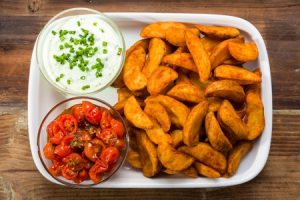What Is Acrylamide ?
Acrylamide is a chemical used in the manufacture of polymers such as polyacrylamide and acrylamide copolymers. These polymers are needed for different production processes such as the manufacture of paper, dyes and plastics. They are also used in the treatment of water for drinking by coagulating unpleasant chemicals, treating sewage and handling wastewater. They also find their way in various consumer products such as food packaging, glues and adhesives and caulking.
Acrylamide is generated in many foods especially high-carbohydrate foods such as fried foods like chips from potatoes. It is also found in asparagus and generated in coffee roasting.

Formation is due to reactions of the amino-acid, asparagine which is commonly found in potatoes. Maillard reactions occur on high heating as in frying between asparagine and reducing sugars which generate acrylamide (Stadler et al., 2002; Mottram et al., 2002). The mechanism of formation occurs by the deamination of 3-aminopropionamide (Granvogl and Schieberle, 2006; Zamora et al., 2009). Acrylamide is also generated from acrylic acid and acrolein (Yasuhara et al., 2003).
Acrylamide is a component in cigarette smoke and also causes nerve damage and is listed as a neurotoxin.
Cancer And Acrylamide
Acrylamide is still a mystery chemical for many where food and cancer is concerned. A number of laboratory studies have shown acrylamide causes cancer in lab animals. When investigated in rats, acrylamide has a potency similar to certain other well-known carcinogens formed through cooking. These include certain aromatic hydrocarbons formed in meat when fried or grilled.
Studies in rat and mouse models have established that exposure to acrylamide increases the risk for several types of cancer (Dearfield et al., 1988; 1995; Friedman, 2003; NTP, 2012).
Acrylamide is converted to a compound called glycidamide and this is known to cause mutations and damage to DNA. However, as the USA’s National Cancer Institute state on their web-site, there are no epidemiological studies which are both case-control and cohort studies in humans showing consistent evidence that dietary acrylamide exposure is associated with the risk of any type of cancer (Virk-Baker et al., 2014).
Regulations
California has a Proposition 65 known as the “Safe Drinking Water and Toxic Enforcement Act of 1986”. The law in this state requires a cancer warning on the consumer product label if the average daily consumption level exceeds certain limits. Two pressure groups are suing various well known companies and businesses including coffee suppliers and fast-food restaurants for refusing to put such warnings on their products or simple non-compliance. From 2004, a number of food trade associations are requesting that California exempt acrylamide as posing no significant risk. However, pressure is being applied to avoid making such an assertion.
References
Dearfield, K.L., Abernathy, C.O., Ottley MS, Brantner JH, Hayes PF. Acrylamide: Its metabolism, developmental and reproductive effects, genotoxicity, and carcinogenicity. Mutation Research 1988; 195(1):45–77.
Dearfield KL, Douglas GR, Ehling UH, et al.(1995) Acrylamide: A review of its genotoxicity and an assessment of heritable genetic risk. Mutation Research 1995; 330(1–2):71–99.
Friedman M. Chemistry, biochemistry, and safety of acrylamide. A review. Journal of Agricultural and Food Chemistry 2003; 51(16):4504–4526
Granvogl, M., Schieberle, P. (2006) Thermally generated 3-aminopropionamide as a transient intermediate in the formation of acrylamide. J. Agric. Food Chem. 54(16) pp. 5933–8.
Lipworth, L., Sonderman, J.S., Tarone, R.E., McLaughlin, J.K. (2012) Review of epidemiologic studies of dietary acrylamide intake and the risk of cancer. European Journal of Cancer Prevention 21(4) pp. 375-386.
Mottram, D.S., Wedzicha, B.L., Dodson, A.T. (2992) Acrylamide is formed in the Maillard reaction. Nature 419(6906) pp. 448–449. doi:10.1038/419448a
National Toxicology Program. Toxicology and carcinogenesis studies of acrylamide (CASRN 79-06-1) in F344/N rats and B6C3F1 mice (feed and drinking water studies). National Toxicology Program technical report series 2012; (575):1-234.
Stadler, R.H., Blank, I., Varga, N., et al. (2002) Acrylamide from Maillard reaction products. Nature 419(6906) pp. 449–450. doi:10.1038/419449a
Virk-Baker, M.K., Nagy, T.R., Barnes, S., Groopman, J. (2014) Dietary acrylamide and human cancer: a systematic review of literature. Nutrition and Cancer 66(5) pp. 774-790
Zamora, R., Delgado,R.M., Hidalgo, F.J. (2009) Conversion of 3-aminopropionamide and 3-alkylaminopropionamides into acrylamide in model systems. Molec. Nutr. Food Res. 53(12): pp. 1512–20.
Zamora, R., Hidalgo, F.J. (2008) Contribution of lipid oxidation products to acrylamide formation in model systems. J. Agric. Food Chem. 56(15) pp. 6075–80.



Leave a Reply